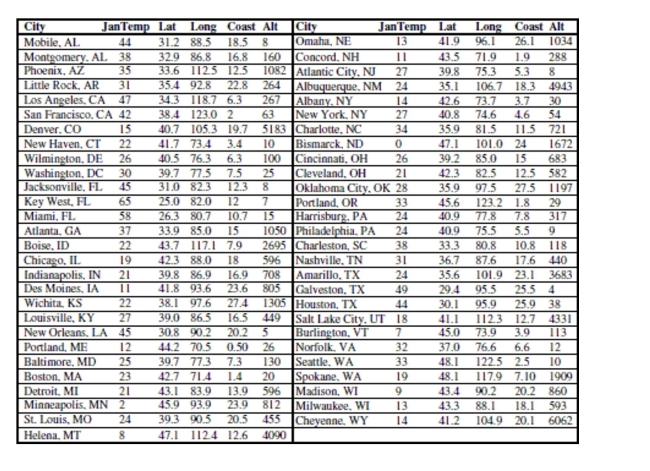Here are data about the average January low temperature in cities in the United States, and factors that might allow us to
predict temperature. The data, available for 55 cities, include:  We will attempt to make a regression model to help account for mean January temperature and to understand the effects of
We will attempt to make a regression model to help account for mean January temperature and to understand the effects of
the various predictors.
At each step of the analysis you may assume that things learned earlier in the process are known.
Units Note: The "degrees" of temperature, given here on the Fahrenheit scale, have only coincidental language relationship to
the "degrees" of longitude and latitude. The geographic "degrees" are based on modeling the Earth as a sphere and dividing it
up into 360 degrees for a full circle. Thus 180 degrees of longitude is halfway around the world from Greenwich, England
(0°) and Latitude increases from 0 degrees at the Equator to 90 degrees of (North) latitude at the North Pole. 
-Now, consider longitude. Should the longitude of a city have an influence on average
January low temperature? Here is the regression: Dependent variable is: JanTemp
R squared R squared (adjusted)
with degrees of freedom
Test the null hypothesis that the true coefficient of Long is zero in this regression. State the
null and alternative hypotheses and indicate your procedure and conclusion.
Definitions:
Susceptible
Likely or prone to be affected by a particular condition or occurrence.
Social Responsibility
The ethical theory that individuals and organizations are obligated to act for the benefit of society at large.
Volunteerism
The practice of offering one's time and services to community projects or organizations without financial compensation.
Adolescents
Young people in the transitional stage of physical and psychological development from childhood to adulthood, typically aged between 13 and 19.
Q4: A factory has 20 assembly lines producing
Q7: Which of the following statements is NOT
Q27: Explain in your own words why a
Q28: On a math test, the scores
Q31: Eight pairs of data yield
Q37: The subjects in which college students major.<br>A)
Q47: Describe the null hypothesis for the test
Q55: Someone suggested that Max arrange the tanks
Q58: 160 students who were majoring in
Q85: When performing a rank correlation test,